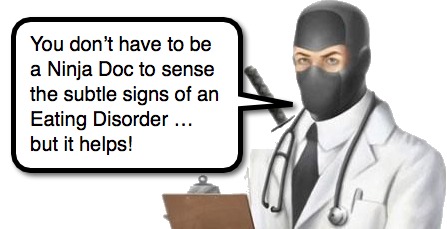Eating Disorders
Most of us entered into the practice of medicine to “make a difference.” {Having read a lot of applicants’ personal statements, I know this to be true.} The realm of Pediatric Emergency Medicine often places us in the most ideal arena to fulfill that calling, but we often are looking at the more dramatic presentations. Let us not forget that our astute diagnostic skills can be extremely useful even when the presentations are less dramatic. Patients with Eating Disorders can often present with subtle cues (see Bradycardia) and if you are vigilant, you can make a profound difference — just like you always wanted to do.
Eating Disorders in the ED
- Prevalence of clinically significant eating disorders in adolescents and adults in the ED is estimated at 16%.
- Patients with eating disorders have been found to have increased utilization of all healthcare services including the EDs.
- Although rare in general adult population, eating disorders are one of the most prevalent chronic disorders in teens and young adults.
- Anorexia Nervous is the third most common chronic condition in adolescent girls – behind obesity and asthma.
- There are several categories of Eating Disorders recognized by the DSM-V (see this nice recap of the criteria and changes from the DSM-IV):
- Anorexia Nervosa
- Bulimia Nervosa
- Binge Eating Disorder
- Eating Disorder Not Otherwise Specified
Anorexia Nervosa
-
Basics
- Peak: women – 15-19 years; men – 10-24 years
- Highest mortality rate of ANY Psychiatric Disorder!
- Suicide accounts for ~20%
- Medical causes account for the majority of mortality associated with anorexia nervosa.
-
Associated Conditions
- High-Level Exercise and Athletic Competition
- Depression or Anxiety Disorder
- Substance Abuse
- Early childhood eating and gastrointestinal problems
- Perfectionism and self-esteem issues
- History of sexual abuse
- “High-concern parenting”
-
Signs and Symptoms
- Hypotension (SBP <90 mmHg, DBP <50 mmHg)
- Bradycardia (HR <60 bpm)
- Brittle nails
- Thinning hair
- Fine lanugo hair on side of face and arms
- Anemia, leukopenia, hypoglycemia, hypophosphatemia – usually only seen with severe disease.
-
Medical Complications
- Cardiovascular
- Decreased cardiac muscle from malnutrition leading to decreased heart function.
- IV fluids need to be given carefully, as pulmonary edema can develop.
- Bradycardia thought to be due to increased vagal tone.
- Serious dysrhythmias can lead to sudden death. Respect Syncope in this patient!
- Mitral Valve Prolapse develops from diminished cardiac muscle mass with the valve remaining unchanged.
- Decreased cardiac muscle from malnutrition leading to decreased heart function.
- Fluid/Electrolytes
- Serious disorders can occur with Refeeding Syndrome
- Hypophosphatemia leading to low ATP levels.
- This impairs muscle contractions in the heart and diaphragm –> arrest.
- Low magnesium and low potassium also can be altered with refeeding syndrome and cause arrhythmias.
- Even a bag of D5 Normal Saline (200 kcal) can be deleterious in the patient who only consumes 400 kcal a day.
- Serious disorders can occur with Refeeding Syndrome
- Gastrointestinal
- Delayed gastric and colonic emptying
- High risk for gastroparesis, gastric distention, GER, constipation, and SMA syndrome.
- Skeletal
- Osteoporosis develops from altered hypothalamic-pituitary axis.
- Back Pain in this patient should not be dismissed as muscle strain.
- Cardiovascular
Bulimia Nervosa
-
Basics
- Self-induced vomiting and abuse of diuretics and laxatives are the most common purging mechanisms.
- Peak: women – 16-20 years
- Bulimia is more common than anorexia.
-
Associated Conditions
- Psychiatric Disorders
- Substance Abuse
- Childhood obesity
- Sexual abuse
- Poor self-esteem
- Parental substance abuse and obesity
- Parental expectations
- Previous dieting
-
Signs and Symptoms
- Likely have normal body weight.
- Painless bilateral hypertrophied salivary glands.
- Poor dentition
- Russell sign – erosions over the dorsum of the hands from self-induced emesis.
- Metabolic alkalosis c/w vomiting (with low potassium)
-
Medical Complications
- Cardiac
- Binge-Purge subtype is at great risk for hypokalemia and subsequent arrhythmias.
- Fluid/Electrolytes
- Metabolic alkalosis, hypochloremia, hypokalemia.
- Chronic contraction alkalosis and dehydration.
- Gastrointestinal
- Odynophagia, hoarseness, dysphagia, heartburn, GER
- Chronic laxative abuse leading to cathartic colon syndrome (damaged intestinal nerve cells).
- Cardiac
SCOFF, but don’t DisMiss it!
- To help you further refine your concern when your sixth-sense is alarming, you can use the screening tool SCOFF.
- Do you ever make yourself SICK, because you feel uncomfortably full?
- Do you worry you have lost CONTROL over how much you eat?
- Have you recently lost more than One Stone (14 pounds) in a 3 month period?
- Do you believe yourself to be FAT when others say you are too thin?
- Do thoughts and FEARS about food and weight dominate your life?
- 2 or more “Yes” answers is suggestive of an eating disorder.
Disposition?
- If the patient is medical stable, then disposition should still include social work and psychiatric consultation to provide resources.
- Particular attention should be paid to the potential for suicidal risk (suicide is frequent with patients who have eating disorders).
- Helping to establish to referral to a eating disorder specialist would be ideal so that all of the medical and comorbid states can be addressed.
- Admission should be considered for those with:
- Adolescent with bradycardia < 50 bpm (Adult < 50 bpm)
- Syncope (potentially concerning for an arrhythmia)
- Severe electrolyte derangement
- Psychiatric disorder concurrent
- Suicidal ideation
References
Trent SA1, Moreira ME, Colwell CB, Mehler PS. ED management of patients with eating disorders. Am J Emerg Med. 2013 May;31(5):859-65. PMID: 23623238. [PubMed] [Read by QxMD]
Dooley-Hash S1, Banker JD, Walton MA, Ginsburg Y, Cunningham RM. The prevalence and correlates of eating disorders among emergency department patients aged 14-20 years. Int J Eat Disord. 2012 Nov;45(7):883-90. PMID: 22570093. [PubMed] [Read by QxMD]




[…] Eating Disordershttps://pedemmorsels.com/eating-disorders/ […]
[…] Fox at Pediatric EM Morsels covers a difficult topic for paediatric doctors – eating disorders. […]
[…] Pediatric EM Morsels: Eating Disorders […]
[…] Fox at Pediatric EM Morsels covers a difficult topic for paediatric doctors – eating disorders. […]